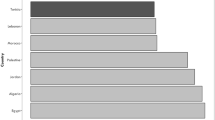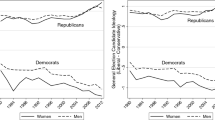Abstract
Candidates frequently engage in partisan trespassing strategies where a candidate will highlight issues and traits associated with stereotypes of the opposing political party. Successful trespassing messages should lead voters to associate candidates with qualities that fit into stereotypes about both Democrats and Republicans, increase electoral support for a candidate, and expand a candidate’s base of support. Few studies, however, investigate whether there are differences in the effects of trespassing strategies across candidate sex. Through three survey experiments, I show that trespassing strategies have both positive and negative effects for female candidates. Voters associate female candidates who trespass with more issues and traits associated with the opposing political party, but voters also associate female candidates with fewer partisan qualities. This trade-off is one that both female and male candidates experience. Male candidates, unlike female candidates, can successfully attract more electoral support from out-partisan voters with trespassing strategies. These findings have broad implications for the viability of female candidates in national and state elections where candidates must secure support across a broad coalition of partisan and out-partisan voters.



Similar content being viewed by others
Notes
Pure independents comprised less than 5% of the samples and are excluded from the analyses.
Web Appendix 3 includes information about the stimuli pre-tests.
Web Appendix 3 includes more information on the key measures.
Web Appendix 4 displays the results broken out by candidate partisanship.
References
Banda, K. K. (2013). The dynamics of campaign issue agendas. State Politics & Policy Quarterly,13(4), 446–470.
Bauer, N. M. (2015a). Emotional, sensitive, and unfit for office: Gender stereotype activation and support for female candidates. Political Psychology,36(6), 691–708. https://doi.org/10.1111/pops.12186.
Bauer, N. M. (2015b). Who stereotypes female candidates? Identifying individual differences in feminine stereotype reliance. Politics, Groups, and Identities,3(1), 94–110.
Bauer, N. M. (2017). The effects of counter-stereotypic gender strategies on candidate evaluations. Political Psychology,38(2), 279–295. https://doi.org/10.1111/pops.12351.
Bauer, N. M. (2018). Untangling the relationship between partisanship, gender stereotypes, and support for female candidates. Journal of Women, Politics & Policy,39(1), 1–25.
Bauer, N. M., & Carpinella, C. (2018). Visual communication and candidate evaluation: The influence of feminine and masculine images on support for female candidates. Political Research Quarterly,71(2), 395–407.
Bauer, N. M., Harbridge, L. Y., & Krupnikov, Y. (2017). Who is punished? Conditions affecting voter evaluations of legislators who do not compromise. Political Behavior,39(2), 379–400.
Berinsky, A. J., Huber, G. A., & Lenz, G. S. (2012). Evaluating online labor markets for experimental research: Amazon.com’s mechanical turk. Political Analysis,20(3), 351–368.
Berinsky, A. J., Margolis, M. F., & Sances, M. W. (2014). Separating the shirkers from the workers? Making Sure respondents pay attention on self-administered surveys. American Journal of Political Science,58(3), 739–753.
Bishin, B. G., Stevens, D., & Wilson, C. (2006). Character counts: Honesty and fairness in election 2000. Public Opinion Quarterly,70(2), 235–248.
Bos, A. L., Schneider, M. C., & Utz, B. L. (2017). Gender stereotypes and prejudice in U.S. elections. In C. Travis & J. White (Eds.), APA Handbook of the Psychology of Women (pp. 367–384). Washington, DC: American Psychological Assocaition.
Brooks, D. J. (2013). He runs, she runs. Princeton: Princeton University Press.
Campbell, A., Converse, P. E., Miller, W. E., & Stokes, D. E. (1960). The American voter. New York: Wiley.
Cassese, E. C., & M. R. Holman. 2018. Playing the woman card: Ambivalent sexism in the 2016 U.S. presidential race. Political Psychology forthcoming.
Cassese, E. C., & Holman, M. R. (2017). Party and gender stereotypes in campaign attacks. Political Behavior. https://doi.org/10.1007/s11109-017-9423-7.
Conover, P. J. (1988). The role of social groups in political thinking. British Journal of Political Science,18, 51–76.
Darcy, R., & Schramm, S. S. (1977). When women run against men. Public Opinion Quarterly,41, 1–12.
Ditonto, T. M. (2017). A high bar or a double standard? Gender, competence, and information in political campaigns. Political Behavior. https://doi.org/10.1007/s11109-016-9357-5.
Ditonto, T. M., Hamilton, A. J., & Redlawsk, D. P. (2014). Gender stereotypes, information search, and voting behavior in political campaigns. Political Behavior,36(2), 335–358.
Dittmar, K. (2015). Navigating gendered terrain: Stereotypes and strategy in political campaigns. Philadelphia: Temple University Press.
Dolan, K. (2014). When does gender matter? Women candidates & gender stereotypes in american elections. New York: Oxford University Press.
Druckman, J. N., Jacobs, L. R., & Ostermeier, E. (2004). Candidate strategies to prime issues and image. Journal of Politics,66(4), 1180–1202.
Eagly, A. H., & Karau, S. J. (2002). Role congruity theory of prejudice toward female leaders. Psychological Review,109(3), 573–594. https://doi.org/10.1037//0033-295X.109.3.573.
Egan, P. J. (2013). Partisan priorities: How issue ownership drives and distorts American politics. New York: Cambridge University Press.
Elis, R., Hillygus, D. S., & Nie, N. (2010). The dynamics of candidate evaluations and vote choice in 2008: looking to the past or future? Electoral Studies,29(4), 582–593. https://doi.org/10.1016/j.electstud.2010.04.005.
Fox, R. L. (2010). Congressional elections: Women’s candidacies and the road to gender parity. In S. J. Carroll & R. L. Fox (Eds.), Gender and elections: Shaping the future of American politics (pp. 187–209). New York: Cambridge University Press.
Fridkin, K. L., & Kenney, P. J. (2009). The role of gender stereotypes in U.S. senate campaigns. Politics & Gender,5, 301–329.
Fridkin, K. L., & Kenney, P. J. (2011). The role of candidate traits in campaigns. Journal of Politics,73(1), 61–73.
Fridkin, K. L., & Kenney, P. J. (2015). The changing face of representation: The gender of U.S. senators and constituent communications. Ann Arbor: University of Michigan Press.
Funk, C. L. (1999). Bringing the candidate into models of candidate evaluation. Journal of Politics,61(3), 700–720.
Hayes, D. (2005). Candidate qualities through a partisan lens: A theory of trait ownership. American Journal of Political Science,49(4), 908–923.
Hayes, D. (2011). When gender and party collide: Stereotyping in candidate trait attribution. Politics & Gender,7(2), 133–165. https://doi.org/10.1017/S1743923X11000055.
Hayes, D., & Lawless, J. L. (2015). As local news goes, so goes citizen engagement: Media, knowledge, and house elections. Journal of Politics,77(2), 447–462.
Hayes, D., & Lawless, J. L. (2016). Women on the run: Gender, media, and political campaigns in a polarized era. New York: Cambridge University Press.
Herrick, R. (2016). Gender themes in state legislative candidates’ websites. The Social Science Journal,53, 282–290.
Herrnson, P. S., Celeste Lay, J., & Stokes, A. K. (2003). Women running as ‘women’: Candidate gender, campaign issues, and voter targeting strategies. The Journal of Politics,65, 244–255.
Hitchon, J. C., & Chang, C. (1995). Effects of gender schematic processing on the reception of political commercials for men and women candidates. Communication Research,22(4), 430–458.
Holman, M. R., Merolla, J. L., & Zechmeister, E. J. (2016). Terrorist threat, male stereotypes, and candidate evaluations. Political Research Quarterly,69(1), 134–147.
Holman, M. R., Merolla, J., & Zechmeister, E. (2017). Can experience overcome stereotypes in times of terror threat? Research and Politics,2017, 1–7.
Huddy, L. (2001). From social to political identity: A critical examination of social identity theory. Political Psychology,22(1), 127–156.
Huddy, L., & Capelos, T. (2002). Gender stereotyping and candidate evaluation: Good news and bad news for women politicians. In V. C. Ottati, R. S. Tindale, J. Edwards, F. B. Bryant, L. Heath, Y. Suarez-Balcazar, & E. J. Posavac (Eds.), The social psychology of politics (pp. 29–54). New York: Kluwer Publishers.
Huddy, L., & Terkildsen, N. (1993). Gender stereotypes and the perception of male and female candidates. American Journal of Political Science,37(1), 119–147.
Iyengar, S., Valentino, N. A., & Ansolabehere, S. (1996). Running as a woman: Gender stereotyping in political campaigns. In P. Norris (Ed.), Women, the media and politics (pp. 77–98). New York: Oxford University Press.
Kinder, D. R., Peters, M. D., Abelson, R. P., & Fiske, S. T. (1980). Presidential prototypes. Political Behavior,2, 315–337.
Klar, S., & Krupnikov, Y. (2016). Independent politics: How American disdain for parties leads to political inaction. New York: Cambridge University Press.
Krupnikov, Y., & Bauer, N. M. (2014). The relationship between campaign negativity, gender and campaign context. Political Behavior,36(1), 167–188.
Krupnikov, Y., Piston, S., & Bauer, N. M. (2016). Saving face: Identifying voter responses to black and female candidates. Political Psychology,37(2), 253–273. https://doi.org/10.1111/pops.12261.
Lodge, M., McGraw, K., & Stroh, P. (1989). An impression-driven-model of candidate evaluation. American Political Science Review,83(2), 399–419.
McGraw, K. M. (2003). Political impressions: Formation and management. In D. O. Sears, L. Huddy, & R. Jervis (Eds.), Handbook of political psychology. Oxford: Oxford University Press.
McGraw, K. M., Lodge, M., & Stroh, P. (1990). On-line processing in candidate evaluation: The effects of issue order, issue importance, and sophistication. Political Behavior,12(1), 41–58.
Miller, A. H., Wattenberg, M. P., & Malanchuk, O. (1986). Schematic assessments of presidential candidates. American Political Science Review,80(2), 521–540.
Morton, R. B., & Williams, K. C. (2010). Experimental political science and the study of causality: From nature to the lab. New York: Cambridge University Press.
Mutz, D. C. (2011). Population based survey experiments. Princeton, NJ: Princeton University Press.
Petrocik, J. R. (1996). Issue ownership in presidential elections, with a 1980 case study. American Journal of Political Science,40(3), 825–850.
Rahn, W. M. (1993). The role of partisan stereotypes in information processing about political candidates. American Journal of Political Science,37(2), 472–496.
Riker, W. (1996). The strategy of rhetoric: Campaigning for the American Constitution. New Haven: Yale University Press.
Sanbonmatsu, K., & Dolan, K. (2009). do gender stereotypes transcend party? Political Research Quarterly,62(3), 485–494.
Schneider, M. C. (2014a). The effects of gender-bending on candidate evaluations. Journal of Women, Politics, and Policy,35, 55–77.
Schneider, M. C. (2014b). Gender-based strategies on candidate websites. Journal of Political Marketing,13(4), 264–290. https://doi.org/10.1111/pops.12040.
Schneider, M. C., & Bos, A. L. (2014). Measuring stereotypes of female politicians. Political Psychology,35(2), 245–266.
Schneider, M. C., & Bos, A. L. (2016). The intersection of party and gender stereotypes in evaluating political candidates. Journal of Women, Politics & Policy,37(3), 274–294.
Seltzer, R., Newman, J., & Leighton, M. (1997). Sex as a political variable: Women as candidates and voters in U.S. elections. Boulder, CO: Lynne Rienner Publishers.
Sides, J. (2006). The origins of campaign agendas. British Journal of Political Science,36(3), 407–436.
Sides, J. (2007). The consequences of campaign agendas. American Politics Research,35, 465–488.
Simon, A. F. (2002). The winning message: Candidate behavior, campaign discourse, and democracy. New York: Cambridge University Press.
Sulkin, T., Moriarty, C. M., & Hefner, V. (2007). Congressional candidates’ issue agendas on- and off-line. International Journal of Press/Politics,12(2), 63–79.
Tajfel, H. (1974). Social identity and intergroup behavior. Social Science Information,13(2), 65–93.
Thomsen, D. (2015). Why so few (republican)women? Explaining the partisan imbalance in the US congress. Legislative Studies Quarterly,50(2), 295–323.
Windett, J. (2014). Gendered campaign strategies in U.S. elections. American Politics Research,42(4), 628–655.
Winter, Nicholas J. G. (2010). Masculine republicans and feminine democrats: Gender and Americans’ explicit and implicit images of the political parties. Political Behavior,32(4), 587–618. https://doi.org/10.1007/s11109-010-9131-z.
Acknowledgements
The author would like to thank the four anonymous reviewers and the editor for their very helpful suggestions about how to improve this manuscript.
Author information
Authors and Affiliations
Corresponding author
Additional information
Replication files are available on the Political Behavior Dataverse website, study, https://doi.org/10.7910/DVN/MS0NFV.
Electronic supplementary material
Below is the link to the electronic supplementary material.
Rights and permissions
About this article
Cite this article
Bauer, N.M. The Effects of Partisan Trespassing Strategies Across Candidate Sex. Polit Behav 41, 897–915 (2019). https://doi.org/10.1007/s11109-018-9475-3
Published:
Issue Date:
DOI: https://doi.org/10.1007/s11109-018-9475-3




